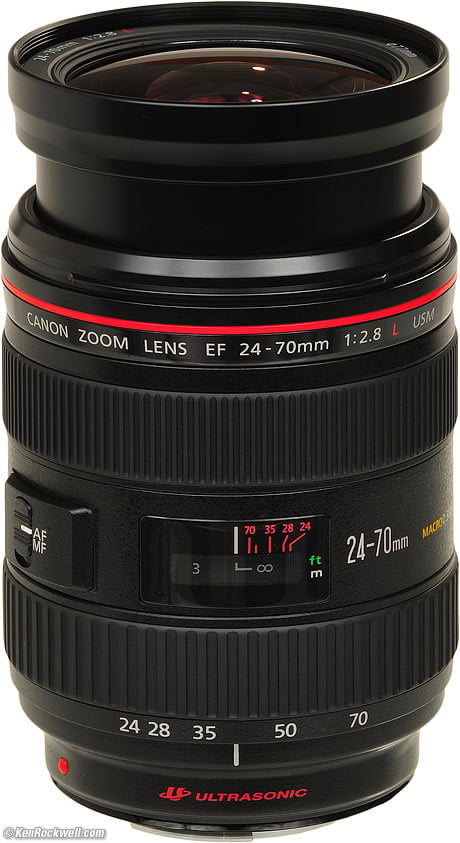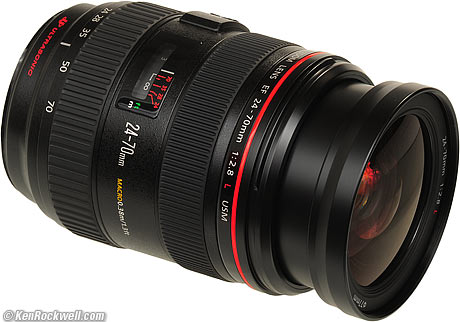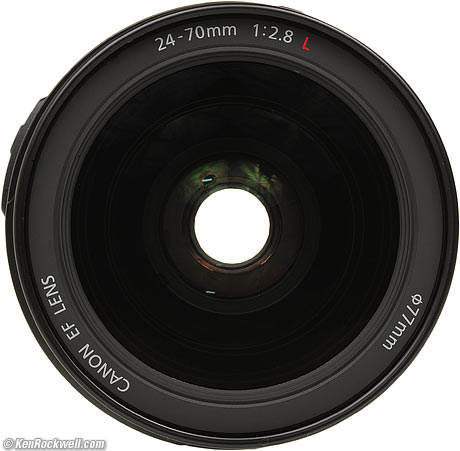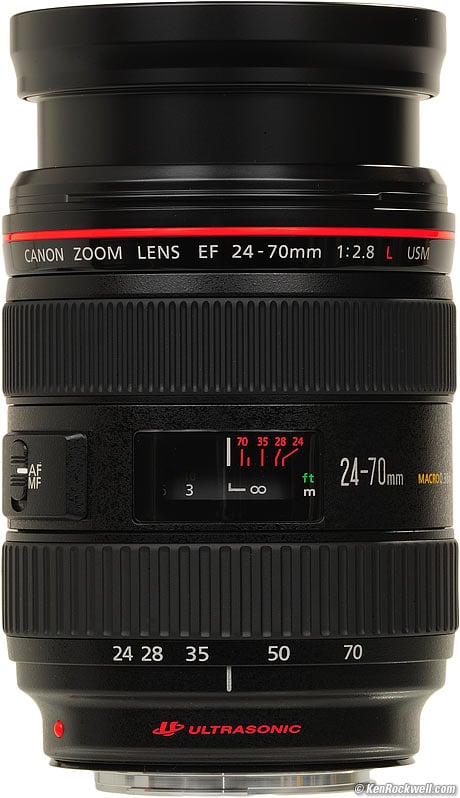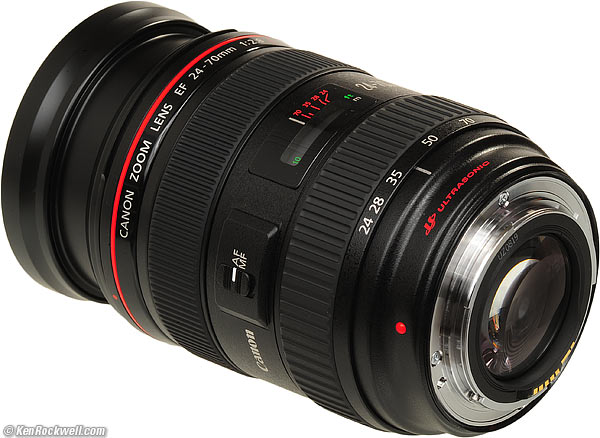Home Donate New Search Gallery Reviews How-To Books Links Workshops About Contact
Canon 24-70mm f/2.8 L
Full-Frame EF L USM (2002-2012)
© KenRockwell.com. All rights reserved.
Intro Specs Performance Compared Recommendations
Canon EF 24-70mm f/2.8 L USM set to 40mm (Metal 77mm filter thread, 1.25 feet/0.38m close-focus, 32.1 oz./910g, about $1,400 used.) enlarge. This free website's biggest source of support is when you use these links, especially these directly to it at Adorama or at Amazon, when you get anything, regardless of the country in which you live. Since it's been made for 15 years, there are also plenty available used at eBay (see How to Win at eBay). Thanks! Ken.
April 2013 More Canon Reviews Canon Lenses All Reviews
NEW: Canon 24-70mm f/2.8 L II. Far more expensive and made mostly out of plastic, but astoundingly even better optically. I liked this original 24-70, but when I tried the new 24-70 2.8 II, I bought it!
Adorama pays top dollar for your used gear, especially this original 24-70mm L.
Introduction top
Intro Specs Performance Compared Recommendations
|
Adorama pays top dollar for your used gear. I use these stores. I can't vouch for ads below.
|
The Canon EF 24-70mm f/2.8 L is one of Canon's best lenses ever. A Canon 24-70/2.8 L has been in just about every pro's bag ever since it was introduced in 2002. This is because it's great optically, ergonomically and mechanically. The only reason not to have one of these lenses is because it's big, heavy and expensive. Once you've gotten yours and carried it to wherever you need, it's a joy to use and the photos are marvelous.
This 24-70 is extremely popular with professional wedding and event photographers. Amateurs usually prefer the Canon 24-105mm f/4 IS because it costs and weighs a little less and has a longer zoom range, however full-time pros prefer this 24-70 because its a stop faster (f/2.8), has less distortion, built a bit tougher and feels better, especially because the zoom range between 24mm and 35mm isn't all bunched together as it is with the 24-105mm.
AF is silent and immediate. You can grab the big manual focus ring for instant manual focus override at any time.
This lens focuses to within 8 inches (20 cm) or closer in front of the lens at all focal length settings, which means that I never have to move back to get something in focus.
Zooming is a breeze, with just the right amount of space between focal lengths to allow fast and precise selection of any focal length. Distortion is minimal and this lens is always sharp.
While the cheaper 24-105mm f/4 IS has Image Stabilization (IS) for sharp hand-held shots of still subjects in dim light, the faster f/2.8 speed of this 24-70mm allows photographing people and action in lower light than with the 24-105mm. IS is of no help with moving subjects; IS only helps with camera shake, not subject motion.
This 24-70mm lens replaces the earlier EF 28-70mm f/2.8 L that was introduced in 1993.
Canon 24-70mm f/2.8 L. enlarge.
Compatibility
This L lens is optimized for 35mm film and full-frame digital, and of course works on 1.3x and 1.6x Canon cameras.
This Canon EF EOS 24-70mm f/2.8 L works perfectly with every Canon EOS camera ever made, meaning every Canon DSLR and every Canon autofocus film camera made since 1987.
This means of course it works great on today's 5D Mark II and Canon 7D, but it works just as well on my original Canon EOS 620 from 1987!
Specifications top
Intro Specs Performance Compared Recommendations
Name
Canon calls this the CANON ZOOM LENS EF 24-70mm f/2.8 L USM.
EF means "electronic focus," meaning that there is an autofocus motor in the lens itself. All Canon lenses since 1987 have been EF.
L only means as expensive as L; it means nothing technically.
USM means Ultra-Sonic Motor. This means autofocus is almost silent, and that you can grab the big focus ring for instant manual focus override at any time.
Optics top
16 elements in 13 groups.
Internal focus: nothing moves externally as autofocused.
Two aspherical elements.
One UD glass element.
Focal Length
24~70mm.
On 1.3x Canon cameras it will see angles-of-view similar to what a 30~90mm lens would see on a 35mm camera.
On 1.6x Canon cameras it will see angles-of-view similar to what a 38~115mm lens would see on a 35mm camera.
Angle of View (on 35mm and full-frame cameras)
84º - 34º diagonal.
53º - 19.5º vertical.
74º - 29º horizontal.
Close Focus top
1.25 feet (0.38m), specified, from the image plane.
Since this lens is so big, this actually means that it focuses to within about 8 inches (20 cm) of the front of the lens at the 70mm setting, and even closer as the lens gets longer at the wider settings.
Maximum Reproduction Ratio top
1:3.45, which is pretty close!
Teleconverters
This lens MAY NOT be used with either of the Canon EF 1.4x II or Canon EF 2x II Teleconverters.
Extension Tubes
Use the Canon EF12 II to get close-ups to about half life-size at the image sensor.
Use the Canon EF25 II to get close-ups to about 3/4 life-size at the image sensor.
Close-up Lenses
Use the Canon 500D to get close-ups at 70mm to about 4/10 life-size at the image sensor.
Diaphragm top
24-70mm f/2.8 wide-open at f/2.8 at 40mm. (EF diaphragm not visible). enlarge.
8 blades.
Reasonably round at large apertures, octagonal at small apertures.
Stops down to f/22.
Hard Infinity Focus Stop? top
No.
You have to let the AF system focus for you at infinity.
Focus Scale top
Yes.
The ring turns from infinity to the closest macro focus distance in about 120.º
Depth-of-Field Scale top
No.
Infra-Red Focus Indices top
Yes, marks for 24mm, 28mm, 35mm, 50mm and 70mm focal length settings.
These marks are for the 800 nm wavelength.
Filter Thread top
77mm.
Metal.
Does not rotate and doesn't move with focus, but does move in and out with zooming.
Size top
Canon specifies 3.28" (83.2mm) diameter by 4.85" (123.3mm) long, when set to 70mm.
It extends as zoomed to shorter focal lengths.
Weight top
32.080 oz. (909.5g), measured.
Canon specifies 33.5 oz. (950g).
Hood top
$50 plastic clip-on EW-83F, included.
Case top
$33 LP1219 sack, included.
Caps top
Standard 77mm ET-77U front, included.
Standard EOS cap rear.
Introduced top
Photokina, 29 September 2002.
Replaced top
2012, by the 24-70mm L II.
Quality top
Made in Japan.
Price, USA top
2012 September: about $1,400 used.
Since Canon's replacement 24-70mm f/2.8 L II sells for $2,300 and does the same thing, needless to say, the price of this lens used is still the same as it was new.
2011 September: $1,400 new.
(220,000 Yen catalog price at introduction in 2002.)
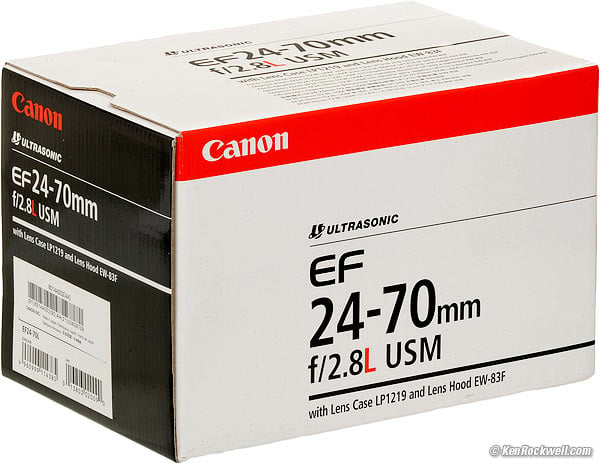
Box, Canon 24-70/2.8 L.
Performance top
Intro Specs Performance Compared Recommendations
Overall Autofocus Bokeh Breathing Color Distortion
Ergonomics Falloff Filters Lateral Color Fringes Macro
Mechanics Sharpness Spherochromatism Sunstars
Overall performance top
The Canon 24-70mm f/2.8 L is optically superb and handles great. I wish everything were this good.
It's heavy and expensive, and good!
Autofocus performance top
Autofocus is fast and silent, as we take for granted with Canon. For the still subjects I shoot, it always seems instantaneous.
Auto/Manual Switching
Just grab the focus ring at any time for instant manual-focus override.
Only move the AF-MF switch if you want to disable the camera from auto focusing.
AF Speed
AF is fast!, as Canons always are.
The AF motor is silent. All you'll hear is some internal sliding.
AF Accuracy and Consistency
I saw no autofocus error on my Canon 5D Mark II.
Especially at f/2.8, all my shots are dead-on at every focal length.
Manual Focus
Manual focus is easy; just grab the ring.
It takes only 120º to go from end-to-end of the focus scale.
Bokeh performance top
Bokeh, the quality of out-of-focus areas as opposed to the degree of defocus, is superb. Backgrounds just melt away.
Out-of-focus backgrounds and foregrounds are soft and undistracting, which is much better than most LEICA lenses.
Of course the background rarely gets very far out of focus at 24mm; if you want soft backgrounds, shoot at 70mm and keep your subject close. Subject distance and focal length are more important to throwing backgrounds out of focus than simply shooting at f/2.8.
Focus Breathing performance top
Focus breathing (the image changing size as focused) is mostly of interest to cinematographers who don't want the image changing size ("breathing") as the lens is focused among different subjects.
The image from the Canon 24-70mm f/2.8 L doesn't change at the wide end as focused more closely, while the image gets slightly larger as focused more closely at the 70mm setting.
Color Rendition performance top
The color balance of this 24-70mm f/2.8 L seems the same as my other Canon EF lenses.
Distortion performance top
The Canon 24-70mm f/2.8 USM has less than the usual distortion we expect in a zoom. It's a little less than average at 24mm (only one-third the distortion of the 24-105mm IS!) and also a little less than usual at 70mm.
There is a bit of barrel distortion at 24mm, a bit of pincushion distortion at 70mm, and nearly none between 35~50mm. All in all, it's never annoying as it can be with most zooms.
For critical use, use these values in Photoshop's Lens Distortion tool to remove it:
Full-Frame and 35mm at 3m (10') |
|
24mm |
+2.5* |
28mm |
+1.5* |
35mm |
+0.5 |
50mm |
-0.7 |
70mm |
-2.0 |
© 2011 KenRockwell.com. All rights reserved.
* Some waviness remains.
Ergonomics performance top
Canon 24-70/2.8 L set to 40mm. enlarge.
Ergonomics are perfect. I wish everything was this nice. Just shoot.
It feels great. Just grab the ring for manual focus, and the AF - MF switch falls right under your thumb.
The zoom and focus rings are made of rubber-covered alloy, not plastic.
The zoom control works great, never stiff or bunched-up at the wide end as it is on the Canon 24-105mm f/4 IS.
The close-focus is closer than I ever need to shoot, and it can shoot this close even at the 70mm setting. I LOVE never having to worry about hitting the close-focus stop.
Falloff (darkened corners) performance top
Falloff is visible on film at f/2.8, and gone by f/4.
My Canon 5D Mark II (as of firmware 2.0.4) has the data to correct this automatically in its Peripheral Illumination Correction menu option, and if you set this (I do), all falloff goes away at every setting.
I've greatly exaggerated this by shooting a flat gray target and presenting it against a gray background.
Canon 24-70mm f/2.8 falloff on full-frame 5D Mk II peripheral illumination control enabled:
© 2011 KenRockwell.com. All rights reserved.
5D Mk II peripheral illumination control disabled (same results on film):
© 2011 KenRockwell.com. All rights reserved.
|
Filters, Use with performance top
Filters are easy.
The sturdy and precise metal threads don't move, and there isn't any problem with vignetting. Feel free to use thick rotating filters. There is no need for expensive "thin" polarizers.
In fact, I can stack a regular filter over my regular polarizer and not get any vignetting on full-frame even at 28mm. At 24mm I get a little, but serves me right.
Lateral Color Fringes performance top
Better than many Canon lenses, there are few lateral color fringes as seen on my Canon 5D Mark II.
At 24mm, there is a little red-blue fringing in the corners, but only if you're in focus out there.
There is none at 35mm and 50mm.
At 70mm there is a tiny bit of yellow-blue in the corners if you have something in perfect focus out there, but I never noticed any of this until I looked for it quite deliberately.
Macro performance top
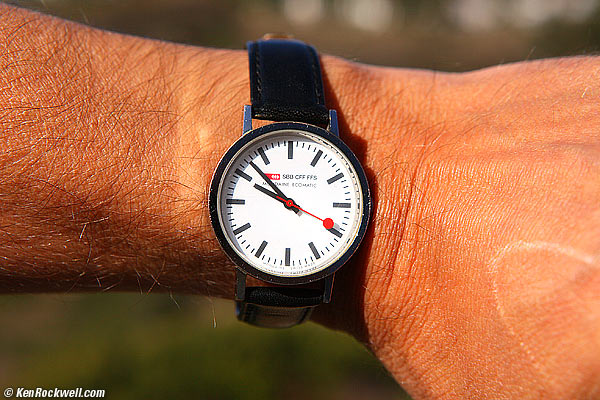
At close-focus distance at 70mm on full-frame, Canon 24-70 f/2.8 L.
Macro is great; I never need to get any closer than I can with this lens.
The images would be even tighter on smaller-format cameras (see crop factor).
Mechanics performance top
Rear, Canon 24-70 f/2.8 L. enlarge.
The Canon 24-70mm f/2.8 L is made much better than most Canon EF and L lenses. It feels smooth like a dream, and has plenty of metal — not plastic — for its control rings and filter threads.
Its metal is smooth and precise, and wonderfully finished. It is so much nicer than the plastic front barrel of too many other expensive lenses today, like the Canon 24-105mm f/4 IS and the much more expensive Nikon 24-70mm f/2.8, both of which have plastic filter threads.
Yes, this older lens is much, much better made than the mostly plastic new 24-70mm L II.
Canon claims good dust and rain sealing, and I tend to believe them on this. Sports pros shoot this out in the rain all the time, although you won't find me out there!
Filter Threads
Metal.
Fore Barrel
Metal.
Hood Mount
Plastic.
Identity Ring
Metal.
Focus Ring
Metal, rubber-covered.
Mid-barrel
Plastic.
Internals
Seem like metal.
Zoom Ring
Metal, rubber-covered.
Rear barrel
Plastic.
Moisture seal at mount
Yes.
Mount
Chromed metal.
Markings
Paint.
Serial Number
Engraved into lens mount flange and filled with black paint.
Date Code
Yes, hot-stamped into the rear light shield.
Use the Canon Date Code Converter to find your lens' birthday.
This sample is stamped UZ0819, meaning August 2011
Noises When Shaken
Moderate clunking.
Made in
Japan.
Sharpness performance top
As shot on the 5D Mark II under test conditions at infinity, the Canon 24-70mm f/2.8 L is super-sharp, even at f/2.8.
The sharpness of the 24-70mm f/2.8 L doesn't vary much except from diffraction at f/11 and smaller. It's just as sharp and contrasty at f/2.8 in the center as it is at f/8.
Depending on your particular sample, the far corners at f/2.8 on full-frame can be slightly less sharp, but you'll never see this unless you're shooting flat subjects that are actually in perfect focus on the sides at f/2.8. If you're shooting test targets (or landscapes at infinity), the sides get slightly sharper as stopped down; but they're still OK at f/2.8, and the 24-70/2.8's relative lack of lateral color fringes is far more important.
The only way to make the 24-70/2.8 look less sharp is to look in the far corners of full-frame at f/2.8 at 24mm, the far sides at 50mm at f/2.8, or the sides at 70mm at f/2.8. It's always sharp all over at 35mm, and sharp all over as stopped down.
The biggest detriment to sharpness will be lack of proper focus and subject motion.
Here are Canon's claimed MTF curves, which agree with what I see:
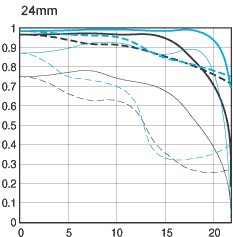
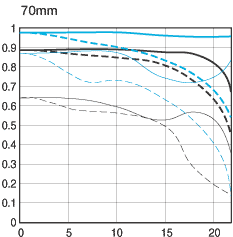
Canon's MTF Curves.
Spherochromatism performance top
I saw no spherochromatism
Spherochromatism, misnamed "color bokeh" by laymen, is when out-of-focus highlights take on color fringes. The Canon 24-70/2.8 L's out-of-focus highlights have no color fringes.
Spherochromatism is a completely different aberration from lateral color fringes.
Sunstars performance top
With its conventional 8-bladed diaphragm, this Canon 24-70mm f/2.8 L should make boring Canon-standard 8-pointed sunstars on brilliant points of light.
Compared top
Intro Specs Performance Compared Recommendations
NEW: All 24-70mm Lenses Compared.
This 24-70mm is the choice of the pros because of its superior handling, fast f/2.8 speed and smooth and tough mechanics.
The Canon 24-105mm f/4 IS is more popular with weekenders because it costs and weighs a little less and has a very slightly longer zoom range. The 24-105's IS helps with handholding, but only with still subjects, while the other f/2.8 lenses are better for shooting action and people in low light. The 24-105mm f/4 IS has horrible distortion at 24mm, and is a pain to set for precise framing at the wide end because its wide focal-length settings are piled on top of each other.
Recommendations top
Intro Specs Performance Compared Recommendations
The Canon 24-70mm f/2.8 L USM is a favorite lens of thousands of professional photographers because of its fabulous optics and great ergonomics.
It's heavy and expensive, and its utility, performance and handling are what earn it a spot in most pro's bags.
A midrange zoom like this is very popular with many news and full-time professional wedding and event shooters. Personally, I carry the flyweight Canon EF 50mm f/1.8 II instead because it's even faster and sharper, weighs one-seventh as much and costs less than one-tenth as much. I'd rather take a few steps forward or back and save all the weight!
If you've found the effort I've spent in sharing this professional review helpful, this free website's biggest source of support is when you use these links, especially these directly to it at Adorama or at Amazon, when you get anything, regardless of the country in which you live. Since it's been made for years, there are also plenty available used at eBay (see How to Win at eBay).
Thanks!
Ken.
More Information:
Canon's 24-70/2.8 L Instruction Manual.
Help me help you top
I support my growing family through this website, as crazy as it might seem.
The biggest help is when you use any of these links to Adorama, Amazon, eBay, Ritz, Calumet, J&R and ScanCafe when you get anything, regardless of the country in which you live. It costs you nothing, and is this site's, and thus my family's, biggest source of support. These places have the best prices and service, which is why I've used them since before this website existed. I recommend them all personally.
If you find this page as helpful as a book you might have had to buy or a workshop you may have had to take, feel free to help me continue helping everyone.
If you've gotten your gear through one of my links or helped otherwise, you're family. It's great people like you who allow me to keep adding to this site full-time. Thanks!
If you haven't helped yet, please do, and consider helping me with a gift of $5.00.
As this page is copyrighted and formally registered, it is unlawful to make copies, especially in the form of printouts for personal use. If you wish to make a printout for personal use, you are granted one-time permission only if you PayPal me $5.00 per printout or part thereof. Thank you!
Thanks for reading!
Mr. & Mrs. Ken Rockwell, Ryan and Katie.
Home Donate New Search Gallery Reviews How-To Books Links Workshops About Contact
